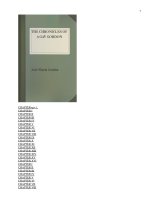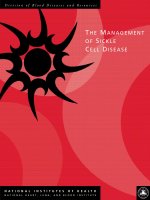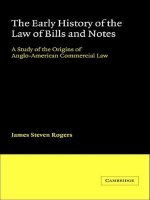Achievement in Mathematics - Improving Student Learning Within the Structure of Professional Learning Communities ppt
Bạn đang xem bản rút gọn của tài liệu. Xem và tải ngay bản đầy đủ của tài liệu tại đây (798.39 KB, 37 trang )
Achievement in Mathematics
© 2009 Math Solutions
Improving Student Learning Within the
Structure of Professional Learning
Communities
Presenters
Patty Clark, Moderator
Education Specialist, Math Solutions
Cathy L. Seeley, Guest Speaker
Past President of National Council of Teachers of Mathematics
Senior
Fellow, Charles A. Dana Center, University of Texas
© 2009 Math Solutions
Senior
Fellow, Charles A. Dana Center, University of Texas
Veteran preK–12 mathematics educator, author and speaker
Paula Hidalgo, Guest Speaker
Director of Product Development, Math Solutions
Former Vice President of Professional Development Group at Pearson
K–12 educator
Agenda
• Effective professional learning communities
• Getting a math PLC started
• Support for existing math PLCs
•
Types of resources for math PLCs
© 2009 Math Solutions
•
Types of resources for math PLCs
• Q&A
The Power of PLCs
“The most promising strategy for sustained,
substantive school improvement is developing
the ability of school personnel to function as
professional learning communities.”
© 2009 Math Solutions
professional learning communities.”
DuFour, Richard, and Robert Eaker. 1998. Professional Learning Communities at Work: Best
Practices for Enhancing Student Achievement. Alexandria, VA: Association for Supervision and
Curriculum Development, xi.
The Power of PLCs
Mike Schmoker states, “[PLCs] may represent
the richest, most unprecedented culmination
of the best we know about authentic school
improvement.”
© 2009 Math Solutions
improvement.”
DuFour, Richard, Robert Eaker, and Rebecca DuFour, eds. 2005. On Common Ground: The
Power of Professional Learning Communities. Bloomington, IN: Solution Tree, 136.
Cathy L. Seeley
Senior Fellow, Charles A. Dana Center, University of
Texas
Past President of National Council
of Teachers of Mathematics (NCTM)
© 2009 Math Solutions
Texas
Veteran preK–12 mathematics educator
Author and speaker
A Professional Learning
Community
An opportunity to work together in purposeful
ways to help students learn what we want
them to learn
—
to “get it.”
© 2009 Math Solutions
them to learn
—
to “get it.”
Effective PLCs:
- Ensure that students learn
-
Focus on results
Effective Professional Learning
Communities
© 2009 Math Solutions
-
Focus on results
- Create a culture of collaboration
(and actually collaborate)
DuFour, Richard. 2004. “What Is a Professional Learning Community?” Educational
Leadership 61 (8): 6–11.
P Is for Professional
• Professional mathematics educators assume
responsibility for helping every student learn
relevant and challenging mathematics. We:
–
Identify important mathematical knowledge,
© 2009 Math Solutions
–
Identify important mathematical knowledge,
thinking, and skills
– Direct all our work toward ensuring that all
students learn math
Professionals Focus on Their
Practice
• What can I/we do to help students learn content?
• What is this student doing well? Where is he/she
struggling?
•
How can I restructure my next lesson based on the
© 2009 Math Solutions
•
How can I restructure my next lesson based on the
lesson I just gave?
• What can I learn from colleagues about how to help
students?
• What will it take to keep students from falling
behind?
L Is for Learning
• Focusing on results means paying attention to
what each student is learning or not learning
• Results come from many places:
– Test scores
© 2009 Math Solutions
– Student work
– Collegial conversations
– School-level factors
– Teacher-level factors
– Student-level factors
C Is for Community
Creating a culture of collaboration means:
- Working together so that students learn
- Building capacity—moving from “pockets of
wonderfulness” to community
-
wide success
© 2009 Math Solutions
wonderfulness” to community
-
wide success
- Articulating across grade levels so students
engage in a coherent learning process
Beware of the Bandwagon
• The graveyard of educational fads, Band-Aids, and
bandwagons is full of great ideas implemented in
foolish or shortsighted ways.
•
Don’t let your learning community turn into faculty
© 2009 Math Solutions
meetings in disguise:
– Checklists
– Mandates that result in superficial collaboration
– Rigid or fixed ideas of what it should be
(leaving no room for opportunities to truly transform how
we help students learn)
Focus on the Big Picture
• Continually reflect on how/whether you are
using your professional learning community to
help students.
•
It’s not just about getting together; it’s about
© 2009 Math Solutions
•
It’s not just about getting together; it’s about
a different way of thinking about our jobs as
educators, really working together, and
approaching our work in more effective ways.
Paula Hidalgo
Director of Product Development
© 2009 Math Solutions
Former VP of the Professional Development
division at Pearson
Former K–12 educator
Overview
• Starting a successful PLC
• Essential elements of a PLC
• A Math PLC: sample activities
•
Resources for PLCs
© 2009 Math Solutions
•
Resources for PLCs
A PLC Is Started
• Setting: Johnson City High School in New York
• Content Area: Mathematics
• Issue: Only 47% of students passed the New
York Regents competency exam
© 2009 Math Solutions
York Regents competency exam
DuFour, Richard, Robert Eaker, and Rebecca DuFour, eds. 2005. On Common Ground: The
Power of Professional Learning Communities. Bloomington, IN: Solution Tree, xvi.
Actions Taken
• Teachers divided essential skills and
knowledge from the Regents exam into four
instructional quarters.
•
Teachers met regularly to help each other
© 2009 Math Solutions
•
Teachers met regularly to help each other
prepare, test, and refine best lessons and
strategies they could devise as a group to
address the most difficult topics.
• They designed short-term assessments and
gave frequent feedback on their efforts.
Essential Elements of a PLC
• Clear, concrete, and common goal
• Regular meeting time
•
Use of data to determine learning focus
© 2009 Math Solutions
•
Use of data to determine learning focus
• Frequent assessment to provide feedback
• Planning and revising lessons together
Improving Learning
“Indeed, other factors affect achievement. But
continuous, organized opportunities for
collaboration and assessment that are part of
an ongoing cycle of continuous improvement
allow us to make the most of the best factors
© 2009 Math Solutions
allow us to make the most of the best factors
and strategies and refine practices that
influence teaching and learning.”
Mike Schmoker cited in DuFour, Richard, Robert Eaker, and Rebecca DuFour, eds. 2005. On
Common Ground: The Power of Professional Learning Communities. Bloomington, IN:
Solution Tree, xvi.
Additional Factors for Successful
PLCs
• Support from administrators
• Distributed leadership
•
Infusion of knowledge
© 2009 Math Solutions
•
Infusion of knowledge
Support from Administrators
• Need for a very important shift: focus on
learning, not on teaching
• Learning leader, not instructional leader
•
Principal’s job: monitor, discuss, and support
© 2009 Math Solutions
•
Principal’s job: monitor, discuss, and support
teachers’ progress in achieving high levels of
student learning
Distributed Leadership
• In industry and businesses, the shift was clear
• In Search of Excellence (Peters and Waterman,
1982) stressed group effort over traditional
supervision:
Frequent, tightly focused, collective efforts
© 2009 Math Solutions
–
Frequent, tightly focused, collective efforts
– Measurement to guide and refine short-term plans
– Recognition and celebration of all improvements
• Changes haven’t completely made their way into
education.
Infusion of Knowledge
• Without infusion of knowledge, there is a risk
of using always the same techniques or
approaches.
•
Infusion can be done through books, videos,
© 2009 Math Solutions
•
Infusion can be done through books, videos,
reports, publications, online courses, and
expert input.
• The infusion of knowledge needs to be done
in small doses and based on current needs.
Essential Elements of a PLC
• Clear, concrete, and common goal
• Regular meeting time
• Use of data to determine instructional focus
•
Frequent assessment to provide feedback
© 2009 Math Solutions
•
Frequent assessment to provide feedback
• Planning and revising lessons together
• Support from administrators
• Distributed leadership
• Infusion of knowledge









